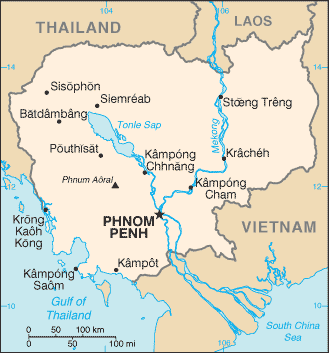Cambodia
 Map Courtesy CIA World Factbook |
The Kingdom of Cambodia (for the various names of the country in Khmer, see naming section below) is a constitutional monarchy in Southeast Asia with a population of over 13 million people. Most Cambodians are Therevada Buddhists of Khmer extraction. A citizen of Cambodia is usually identified as Cambodian, or more often, Khmer. Cambodia is the successor state of the mighty Khmer Empire, which ruled most of the Indochinese Peninsula between the 11th and 14th centuries.
The country shares a border with Thailand to its west, with Laos to its north, with Vietnam to its east, and with the Gulf of Thailand to its south. The geography of Cambodia is dominated by the Mekong river (colloquial Khmer: Tonle Thom, i.e. "the great river") and the Tonle Sap (i.e. "the fresh water river"), an important source of fish.
The first advanced civilizations in present day Cambodia appeared in the 1st millennium AD. During the 300s, 400s, and 500s AD, the Indianized states of Funan and Chenla took hold in what is now present-day Cambodia and southwestern Vietnam. These states had close relations with China and India. After these states collapsed, the Khmer civilization began to flourish in this area from the 9th century to the 13th century.
From the 9th century to the 15th century, Cambodia was the center of the mighty Khmer Empire, which was during this time based at Angkor. Angkor Wat, the empire's main religious temple, remains a symbol of Cambodia during its time as a world power, and is also the country's top tourist attraction to this day. Cambodia was a protectorate of France from 1863 until the country received independence in 1953. During this period, Cambodia was under Japanese occupation during World War II from 1941 to 1945. During the 1950s and 1960s the country was under the rule of King Norodom Sihanouk, where the country maintained a precarious neutrality in the wake of active aggression against South Vietnam by the North Vietnamese.
After the Siamese seized Angkor in 1431, Cambodia began to endure years of foreign domination by neighboring Siam to the west and by Vietnam to the east. This period is known as the "dark ages of Cambodia". This period ended when Cambodia was made a French protectorate in 1863 and became part of French Indochina. Cambodia's chief colonial official was the Resident Superieur (Resident General) while lesser residents, or regional governors were posted in all of the provincial centers. In 1897, the incumbent Resident General complained to his superiors in Paris that the current king of Cambodia, King Norodom, was no longer capable of ruling, and thus received permission to assume the king's roles of issuing decrees, collecting taxes, and appointing royal officials, including the next king. Norodom and his successors thus assumed the role of figureheads and heads of the Buddhist religion. Even in the colonial bureaucracy, French nationals held the highest positions, while even in the lowest rungs of the bureaucracy the colonial government preferred to hire Vietnamese.
During World War II Cambodia was occupied by the Japanese. After it ended in 1945, King Norodom Sihanouk demanded independence from France. With the military situation getting worse throughout Indochina, the French agreed to grant independence to the three states of Vietnam, Laos, and Cambodia in 1953. King Sihanouk, a revered hero in the eyes of his people, returned to Phnom Penh in triumph, and independence was celebrated on November 9, 1953. The last French officials left Cambodia in 1954 after control of residual matters affecting sovereignty, such as financial and budgetary affairs, passed to the new Cambodian state.
In 1969 the USA began B-52 carpet bombing operations in Cambodia. The US administration kept the bombing secret for a time, then claimed it was targeting Viet Cong guerrilla bases, but the raids resulted in the deaths of between 150,00 and 500,00 civilians and the dropping of over half a million tons of explosives. In 1970 the Nixon administration secretly and briefly invaded, and the bombing continued until 1973. During the 1970s and 1980s, the country was plagued with a brutal civil war, a hated military monarchist regime, as well as an even worse genocidal, agro-communist regime led by the Khmer Rouge. During the Khmer Rouge period, autogenocide was committed against millions of people who were perceived intellectuals, detractors of Marxism, and some just innocent civilians. Millions fled across to neighbouring Thailand.
